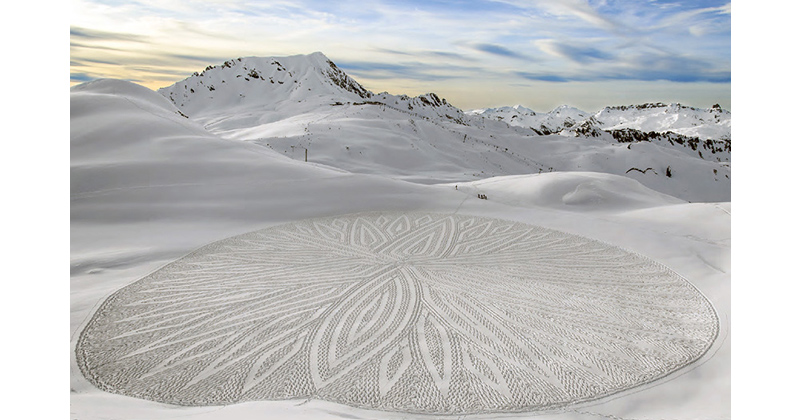‘Snow artist’ Simon Beck creates the most amazing temporary artworks using just a compass, string, measuring tape and a pair of snowshoes. Beck graduated in Engineering from Oxford University but decided later on to leave his office job in order to become a cartographer.
In December 2004 after a day of skiing, he got the idea to draw a star on the small frozen lake in front of his place. His sense for orientation in combination with his passion for outdoor and physical activities inspired him to complete a snow creation. The day after, looking down from the ski lift; he was impressed by the result. After the next snowfall, he repeated the exercise by creating an even more complex drawing. For Simon, a new passion was born.
Beck’s creations have garnered him hundreds of thousands of fans online. His Facebook page boasts over 280,000 Likes and he has just released a 168-page book entitled Snow Art, featuring over 200 images that highlight his last 10 years of creations.
Below you will find a gallery of Simon’s amazing snowshoe art along with questions and answers about his craft sprinkled throughout.
1.
Website | Facebook | Buy the book
2.
Website | Facebook | Buy the book
3.
Website | Facebook | Buy the book
Can you give a brief overview of your process?
Stage 1 is measuring. Usually I work outwards from the center. Straight lines are made by using the compass and walking in a straight line towards a point in the distance, curves are made by judgement. Both require a lot of practice to get it good. When the primary straight lines and curves have been made, points are measured along them using pace counting for distance measurement. Next the secondary lines are added by joining the points determined by the above process Usually I walk the lines 3 times to get them really good, if there is enough time. Lastly the shaded areas are filled in.
4.
Website | Facebook | Buy the book
5.
Website | Facebook | Buy the book
6.
Website | Facebook | Buy the book
How long does it take to create a typical artwork?
About 1 long day for an area of 1.3 hectares. The usual reason for having to stop is tiredness, if I am not too tired I continue into the night until it is complete. Plus time spent indoors studying the best way to do things.
7.
Website | Facebook | Buy the book
8.
Website | Facebook | Buy the book
9.
Website | Facebook | Buy the book
What are the challenges you typically face?
Doing the measuring is difficult in poor visibility and when there are no shadows as walking in straight lines and judging curves is difficult. The hardest past is avoiding a ‘stupid’ mistake, and the most frequent cause of those is a wrong aiming point. Straight lines are made by aiming at a point in the distance but one can easily accidentally aim at the wrong point. Also getting the photo.
10.
Website | Facebook | Buy the book
11.
Website | Facebook | Buy the book
12.
Website | Facebook | Buy the book
What are the perfect weather conditions for snow art?
A heavy snowfall once a week with 6 days of fine cold weather between. This would allow one to make 2 designs per week and get good photos, then re-use the sites the following week.
13.
Website | Facebook | Buy the book
14.
Website | Facebook | Buy the book
15.
Website | Facebook | Buy the book
How long do your pieces usually last?
Until the next heavy snowfall. At one extreme in the 2011 season the first design of the season, Jan 03, could be seen as a ‘ghost’ underneath up to 3 later designs for the whole season. At the other extreme the design I completed at half past midnight on December 19, 2011, had completely disappeared by the time I got up the next morning (although I did get some reasonable night photos of it!)
16.
Website | Facebook | Buy the book
17.
Website | Facebook | Buy the book
18.
Website | Facebook | Buy the book
If you enjoyed this post, the Sifter
highly recommends:
